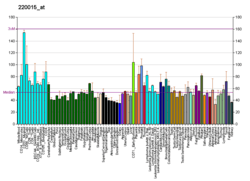CASZ1
Putative survival-related protein is a protein that in humans is encoded by the CASZ1 gene.[5][6]
References
- 1 2 3 GRCh38: Ensembl release 89: ENSG00000130940 - Ensembl, May 2017
- 1 2 3 GRCm38: Ensembl release 89: ENSMUSG00000028977 - Ensembl, May 2017
- ↑ "Human PubMed Reference:".
- ↑ "Mouse PubMed Reference:".
- ↑ Liu Z, Yang X, Tan F, Cullion K, Thiele CJ (May 2006). "Molecular cloning and characterization of human Castor, a novel human gene upregulated during cell differentiation". Biochem Biophys Res Commun. 344 (3): 834–44. doi:10.1016/j.bbrc.2006.03.207. PMID 16631614.
- ↑ "Entrez Gene: CASZ1 castor zinc finger 1".
External links
- Human CASZ1 genome location and CASZ1 gene details page in the UCSC Genome Browser.
Further reading
- Fernandez F, Curtain RP, Colson NJ, et al. (2007). "Association analysis of chromosome 1 migraine candidate genes". BMC Med. Genet. 8: 57. doi:10.1186/1471-2350-8-57. PMC 2034370. PMID 17727731.
- Gregory SG, Barlow KF, McLay KE, et al. (2006). "The DNA sequence and biological annotation of human chromosome 1". Nature. 441 (7091): 315–21. doi:10.1038/nature04727. PMID 16710414.
- Yuan ZR, Wang R, Solomon J, et al. (2006). "Identification and characterization of survival-related gene, a novel cell survival gene controlling apoptosis and tumorigenesis". Cancer Res. 65 (23): 10716–24. doi:10.1158/0008-5472.CAN-05-2176. PMID 16322216.
- Gerhard DS, Wagner L, Feingold EA, et al. (2004). "The Status, Quality, and Expansion of the NIH Full-Length cDNA Project: The Mammalian Gene Collection (MGC)". Genome Res. 14 (10B): 2121–7. doi:10.1101/gr.2596504. PMC 528928. PMID 15489334.
- Ota T, Suzuki Y, Nishikawa T, et al. (2004). "Complete sequencing and characterization of 21,243 full-length human cDNAs". Nat. Genet. 36 (1): 40–5. doi:10.1038/ng1285. PMID 14702039.
- Strausberg RL, Feingold EA, Grouse LH, et al. (2003). "Generation and initial analysis of more than 15,000 full-length human and mouse cDNA sequences". Proc. Natl. Acad. Sci. U.S.A. 99 (26): 16899–903. doi:10.1073/pnas.242603899. PMC 139241. PMID 12477932.
- Suzuki Y, Yoshitomo-Nakagawa K, Maruyama K, et al. (1997). "Construction and characterization of a full length-enriched and a 5'-end-enriched cDNA library". Gene. 200 (1–2): 149–56. doi:10.1016/S0378-1119(97)00411-3. PMID 9373149.
- Maruyama K, Sugano S (1994). "Oligo-capping: a simple method to replace the cap structure of eukaryotic mRNAs with oligoribonucleotides". Gene. 138 (1–2): 171–4. doi:10.1016/0378-1119(94)90802-8. PMID 8125298.
This article is issued from
Wikipedia.
The text is licensed under Creative Commons - Attribution - Sharealike.
Additional terms may apply for the media files.




